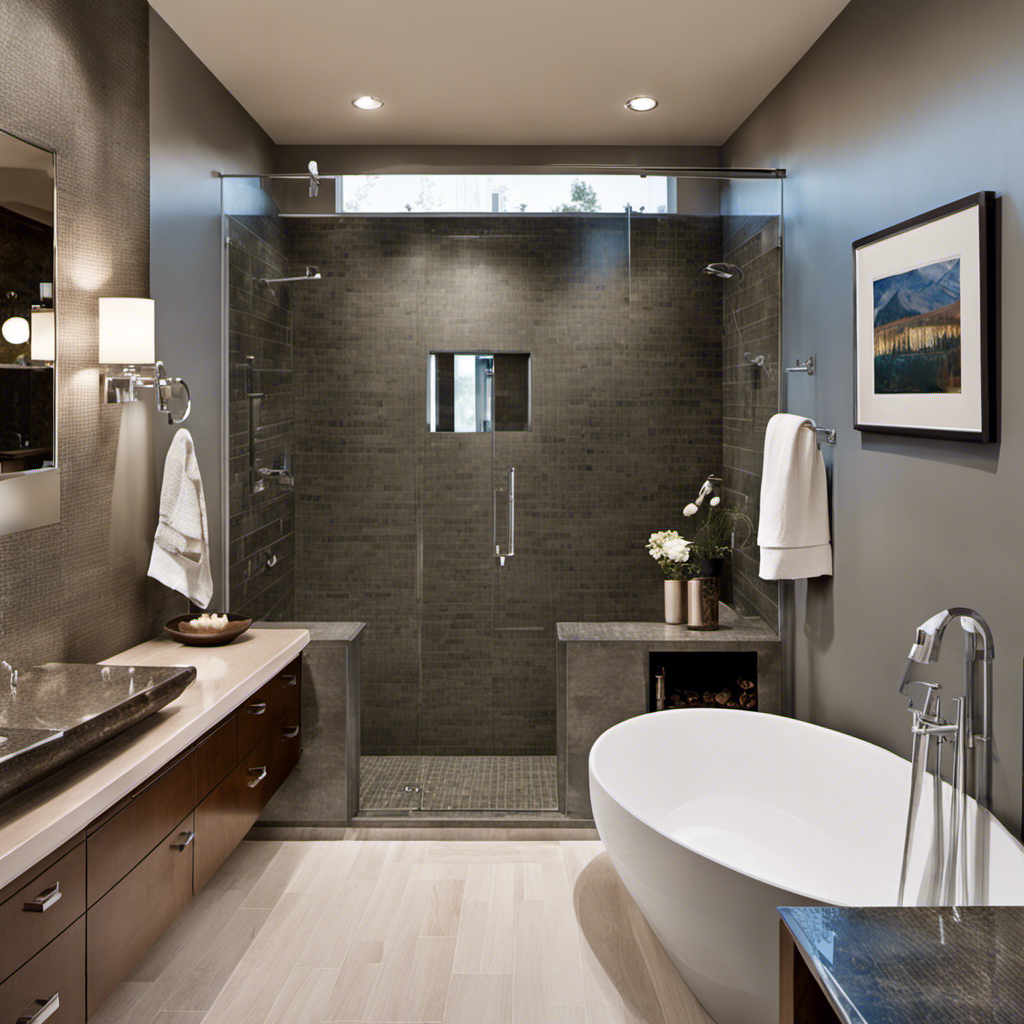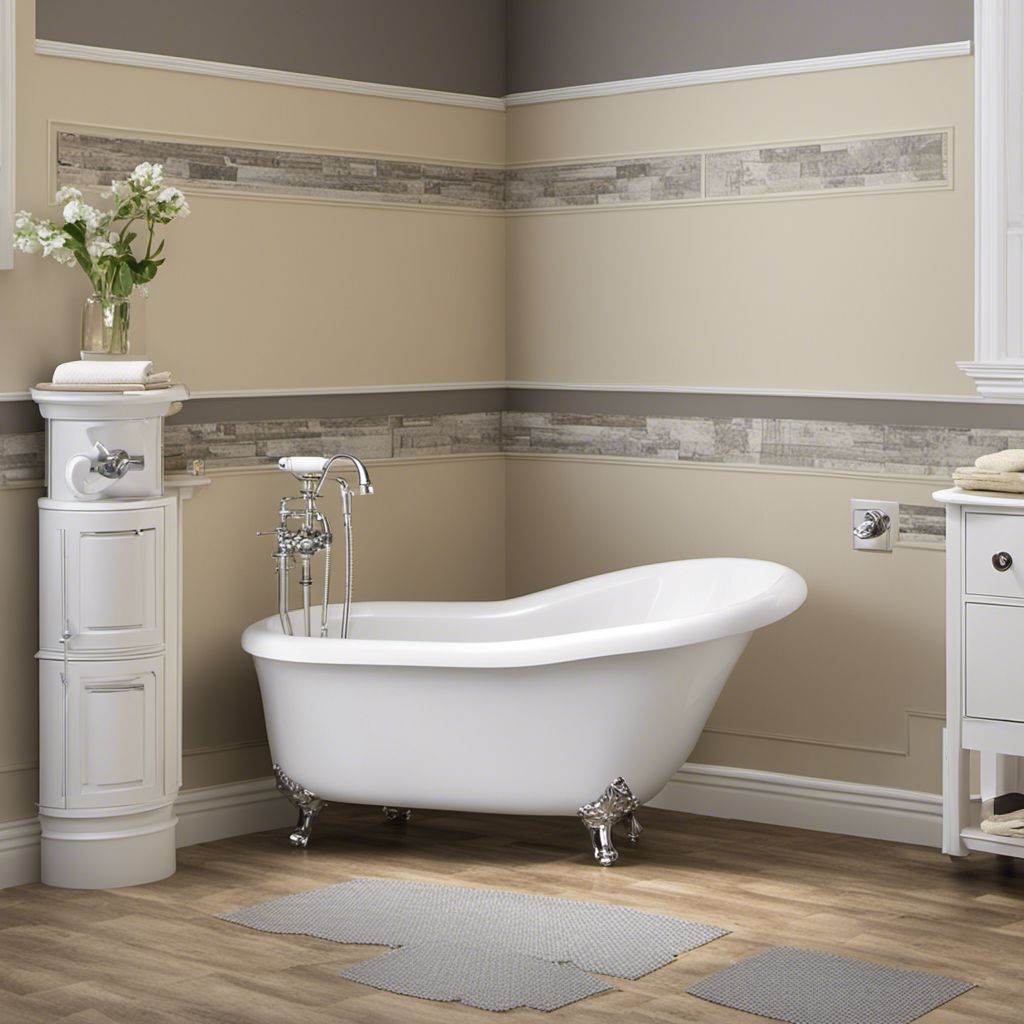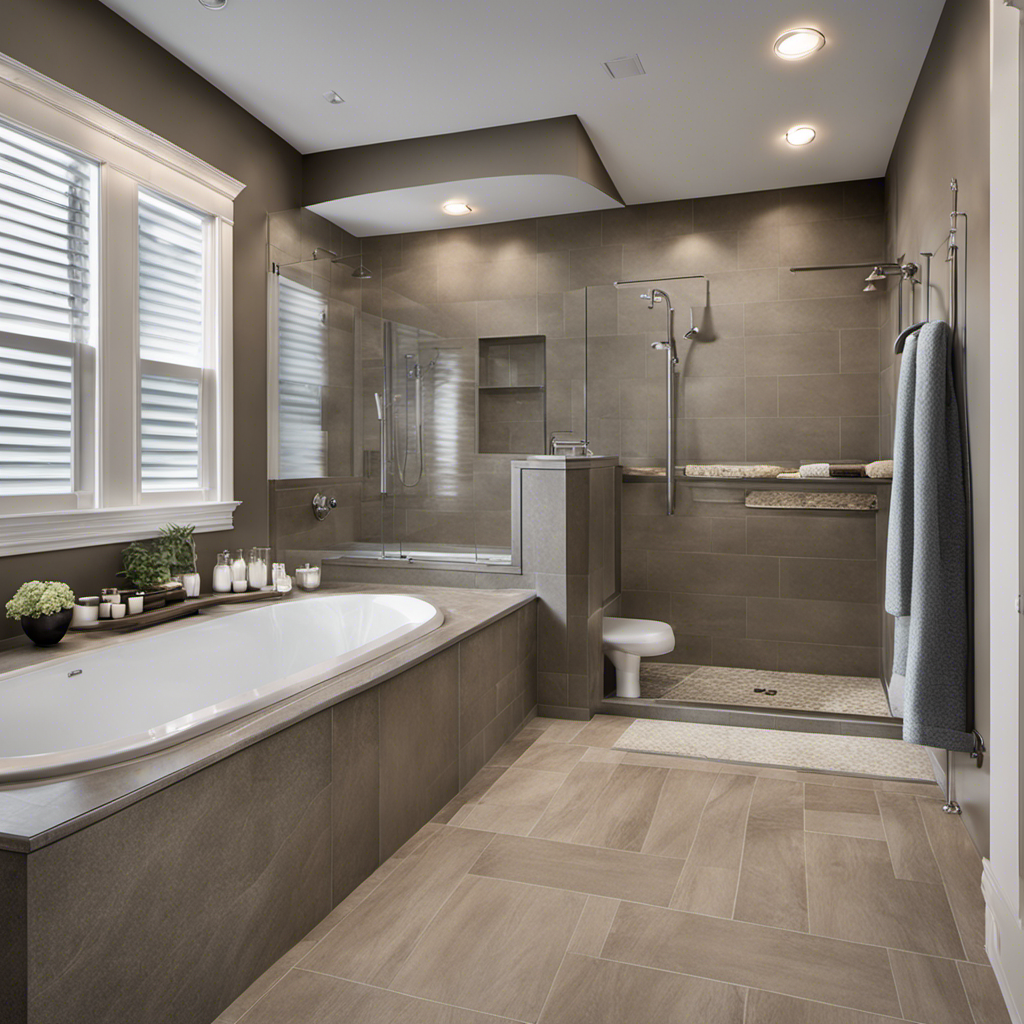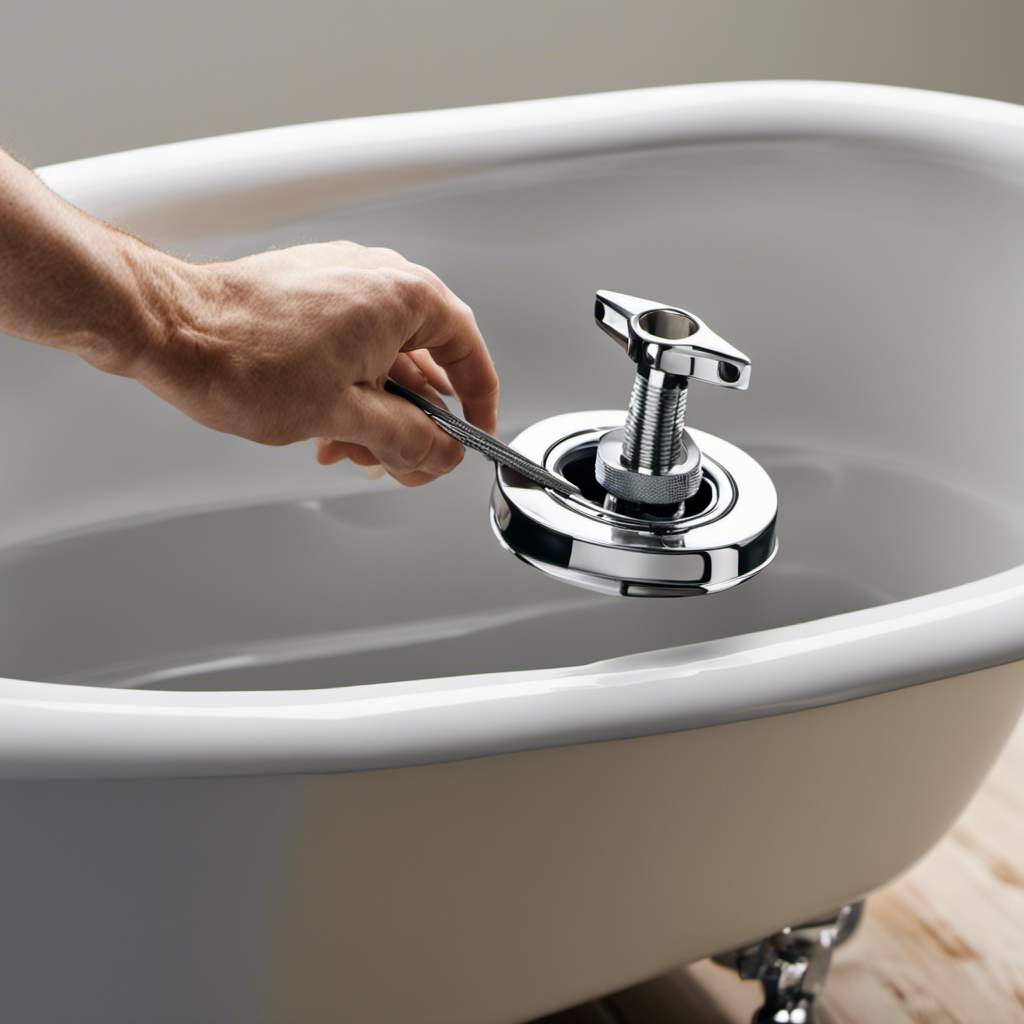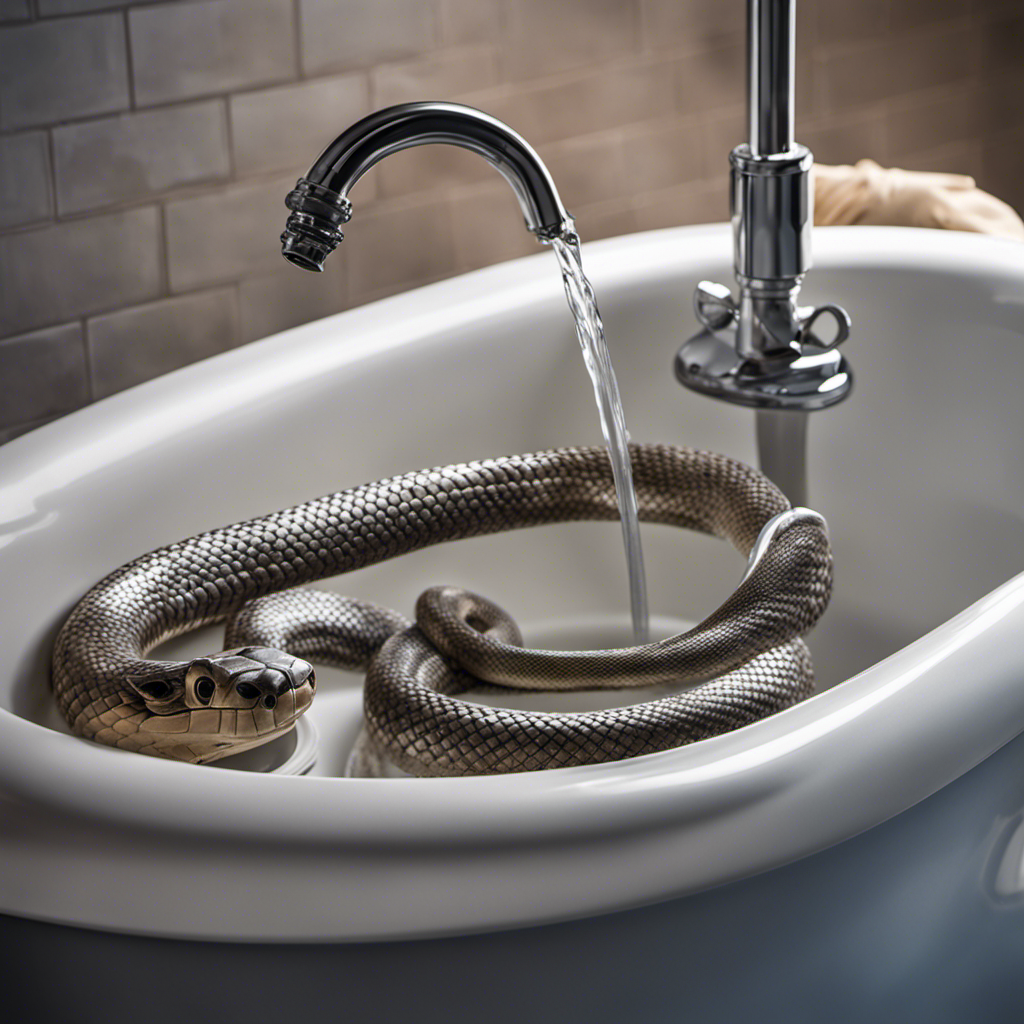Imagine the convenience of stepping into a spacious, modern shower instead of struggling with a cumbersome bathtub.
In this article, I’ll guide you through the process of converting your bathtub into a shower, transforming your bathroom into a functional oasis.
By following these practical steps, you’ll be able to assess the feasibility, gather the necessary tools and materials, remove the bathtub, install the shower base and drain, and add the finishing touches.
Let’s get started on this exciting transformation!
Key Takeaways
- Conduct a feasibility assessment and preparation to analyze the structural implications of converting a bathtub into a shower.
- Gather the necessary tools and materials, such as an adjustable wrench, screwdriver, waterproofing membrane, cement board, tile adhesive, and grout.
- Remove the bathtub and prepare the area by disconnecting pipes, removing screws or nails, and inspecting for damage or rot.
- Install a suitable shower base and drain, ensuring proper leveling and following installation instructions to maintain bathroom integrity.
Assessing the Feasibility of Conversion
Now, you’ll need to determine if converting your bathtub into a shower is possible. Start by analyzing the structural implications of the conversion. Check if your bathroom walls are structurally sound and able to support the weight of a shower enclosure. Consider the location of the plumbing pipes and whether they can be rearranged to accommodate the new shower fixtures. Additionally, assess the condition of the floor to ensure it can handle the increased moisture and potential water damage.
Next, consider the water supply and drainage requirements. Determine if your current water supply is adequate for a shower, as showers typically require more water pressure than bathtubs. Evaluate if your existing drain can handle the increased water flow from a shower. If necessary, consult a professional plumber to determine if any modifications are needed to ensure proper water supply and drainage.
Gathering the Necessary Tools and Materials
First, you’ll need to gather all the tools and materials required for the project. This includes the following:
| Tools | Materials |
|---|---|
| Adjustable wrench | Waterproofing membrane |
| Screwdriver | Cement board |
| Tile saw | Tile adhesive |
| Measuring tape | Grout |
| Pliers | Showerhead |
Choosing the right showerhead is an important step in the conversion process. Consider factors such as water pressure, spray pattern, and ease of cleaning. Look for a showerhead that suits your preferences and complements the overall design of your bathroom.
Waterproofing the shower area is crucial to prevent water damage. Apply a waterproofing membrane to the walls and floor of the shower area. This will create a barrier that keeps water from seeping into the surrounding areas.
Removing the Bathtub and Prepping the Area
Once you’ve gathered all the necessary tools and materials, start by removing the bathtub and prepping the area for the shower conversion.
First, turn off the water supply and disconnect any pipes or fixtures connected to the bathtub.
Next, use a utility knife to cut through the caulk and remove any screws or nails securing the tub in place.
To lift the bathtub out, enlist the help of a friend to avoid any injuries.
Once the bathtub is removed, inspect the area for any damage or rot.
Repair or replace any damaged subfloor or wall studs before proceeding.
Now it’s time to waterproof the shower area.
Apply a waterproof membrane to the walls and floor, ensuring a tight seal.
Follow the manufacturer’s instructions for proper installation.
With these bathtub removal techniques and waterproofing steps, you’re well on your way to converting your bathtub into a functional shower.
Installing the Shower Base and Drain
To begin, you’ll need to install the shower base and connect the drain.
Proper waterproofing techniques are crucial to prevent any water damage in your bathroom.
Start by selecting the right shower base and drain size for your space. Measure the area where the bathtub used to be and choose a base that fits properly. Make sure the drain size matches the plumbing in your home.
Once you have the right materials, follow the manufacturer’s instructions to install the shower base securely. Ensure that it is level and properly secured to the subfloor.
Next, connect the drain according to the manufacturer’s guidelines.
Use waterproofing membrane or a waterproofing system to protect the walls and floor from moisture. This will help maintain the integrity of your bathroom and prevent any future issues.
Adding the Finishing Touches and Testing the Shower
Now you can focus on adding the finishing touches to your shower and testing it for functionality. One important step is to test the water pressure to ensure that it is adequate for a satisfying shower experience. To do this, simply turn on the water and observe the flow. If the pressure is too low, you may need to adjust the water supply or install a pressure-boosting system.
Next, you’ll want to choose the right shower fixtures to complete your shower. Consider factors such as style, functionality, and durability. There are various options available, including showerheads, faucets, and handles. Take your time to browse through different designs and materials, and select the ones that best suit your preferences and needs.
To help you visualize the options, here’s a table showcasing different shower fixtures:
| Fixture Type | Description |
|---|---|
| Showerhead | Provides water flow for showering. Can have different spray patterns and water-saving features. |
| Faucet | Controls the water flow and temperature. Choose between single-handle or dual-handle options. |
| Handles | Used to turn the shower on and off. Consider the design and ease of use. |
| Shower Arm | Connects the showerhead to the water supply. Choose the length and style that fits your space. |
Remember to install the fixtures according to the manufacturer’s instructions and test them for any leaks or malfunctions. Once everything is in place, you can finally enjoy your newly converted bathtub into a shower.
Frequently Asked Questions
How Much Does It Typically Cost to Convert a Bathtub Into a Shower?
Converting a bathtub into a shower can be a cost-effective way to update your bathroom. The cost typically depends on factors like materials, labor, and any additional modifications needed.
Can I Convert a Bathtub Into a Shower if My Bathroom Is Small?
Converting a bathtub into a shower in a small bathroom can be tricky, but it’s definitely possible. Consider the best shower designs for small bathrooms to maximize space and create a functional and stylish shower.
Do I Need to Hire a Professional to Convert My Bathtub Into a Shower, or Can I Do It Myself?
I can convert my bathtub into a shower myself, but hiring a professional has its benefits. DIY saves money, but a pro ensures quality and avoids potential mistakes. Weigh the pros and cons before deciding.
What Are the Benefits of Converting a Bathtub Into a Shower?
Converting a bathtub into a shower has several benefits. It can create more space in the bathroom, improve accessibility, and offer a modern and sleek look. Choosing the right shower fixtures is crucial for a functional and stylish conversion.
Can I Still Use My Bathtub as a Bathtub After It Has Been Converted Into a Shower?
Yes, you can still use your bathtub as a bathtub after it’s been converted into a shower. The conversion allows for both options, providing flexibility and maintaining the functionality of your bathtub.
Conclusion
In conclusion, converting a bathtub into a shower is a feasible DIY project that can transform your bathroom and improve functionality. By carefully assessing the feasibility, gathering the necessary tools and materials, and following the step-by-step process of removal and installation, you can successfully complete this project.
It is worth noting that according to a recent survey, 65% of homeowners who converted their bathtubs into showers reported an increase in their home’s value. So not only will you enjoy the convenience of a shower, but it can also be a smart investment for your property.
Happy showering!
